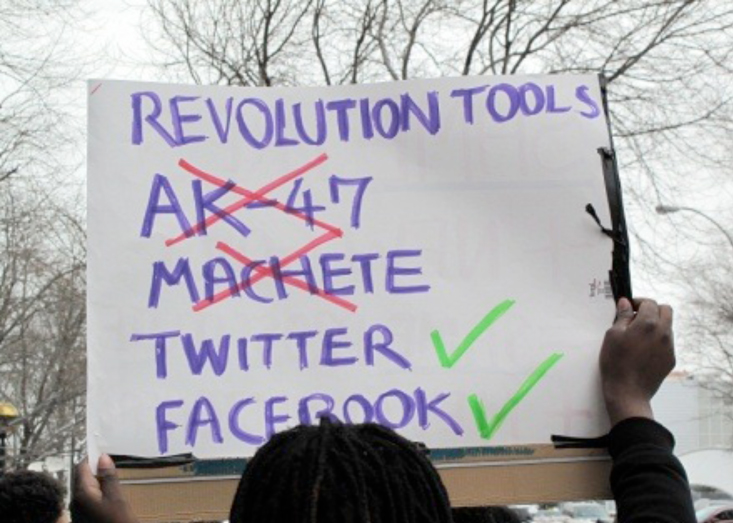HCI, Digital Civics and Agency or: How I Learned to Stop Worrying and Love the… Complexity?
Human Computer Interaction (HCI) emphasises the role of the human in computing research. In studying these interactions, HCI precludes the existence of a level of human agency, involving humans as agents who possess the capacity to perform intentional (and unintentionally derived) actions to bring about change [2, 12].
Agency and the HCI conundrum
Claims that technology allows us to do things that we could have only once dreamed of are common – graphical user interfaces in the 1980s, the internet at the turn of the millennium, and virtual reality today. These claims emphasise personal empowerment and increasing our capacity to act in novel and useful ways [2] – in this way, computers are argued to scaffold agency by enabling us to act.
However, we are simultaneously faced with the temptation to allow computers do the work for us. A predominant vision in HCI [17] – albeit not without its critiques [5, 10] – strives for the automation of mundane tasks, the seamless organisation of our lives in the background, and the gifting of more time for us to do the things that “matter”. In this way, computers are argued to emancipate us and scaffold agency by acting for us.
Compare, for example, two adverts from the 1980s that extoll the values behind the new Apple Macintosh, which not only gives you the ‘power to be your best’ but takes away the need to do any of the hard work (giving you the opportunity to enjoy a much-needed cigar, whilst you contemplate a simpler life before political correctness…)
The civic conundrum
There are also similar contestations of agency in the civic domain. Urban planning provides for a salient example – there is an overarching agenda to improves routes to participation in place-making activities, thus scaffolding the agency of individuals and communities and enabling us to exert our agency. However, this feedback is ultimately gathered so that professional planners possessing the appropriate skills can translate our feelings into legitimate planning issues (see: “material considerations”) and fight our corner against other planning stakeholders, such as developers. Thus “experts” are actually scaffolding agency by acting on behalf of citizens.
The Digital Civics agenda seeks to break from this predictable model and enable citizens to do more for themselves through the use of technology [9]. But how can this agenda sit comfortably alongside a key thrust of HCI that seeks to make computers more powerful, dependable and pervasive? Should we be looking to computers to give us the tools to exert our agency, or to give us more time and energy to exert our agency by doing the work for us? And does advocating more involvement and influence of citizens through individual capacity-building contradict a push for a stronger, more effective and better resourced civic domain that can deliver positive outcomes for citizens?
In this blog post, I wish to explore the issue of agency at the intersection of HCI and Digital Civics with reference to case studies from social computing, ubiquitous computing and civic technology and think about what this means for the Digital Civics research agenda in relation to my research interests.
Theorising agency in HCI
The literature sets out multiple angles on agency, many of which focus on the role of the artefacts acquiring and asserting agency. Latour’s work on interobjectivity [7] suggests that we should understand all material objects to have the capacity for the giving and performing of agency – citing an example of a fence acting to protect a shepherd’s flock whilst the shepherd is asleep. Tholander, Normark and Rossitto [15] develop this in a HCI context to think about how materials talk back to designers during interaction design processes. Speed and Shingleton [13] take this one step further by probing the possibility of objects acquiring and giving us agency through communicating instructions and knowledge.

But what about when it comes to technology scaffolding agency to enable us to act for ourselves? In their literature review of gerontology and HCI, Vines et al [16] articulate that the predominant conception of ageing in the discipline centres around it being a problematic condition that technology can solve by doing things for the person that they are thought to need; without actually treating older users of technology as active agents with the capacity to shape the HCI research agenda itself. Accounts of several HCI deployments also recognise the need to enable users as active agents. For example, Coyle et al [2] evaluate the effects of body-based input on a user’s sense of agency, contrasting this with a parallel experiment investigating the effects of technology acting to assist the user, whilst Kocaballi, Gemeinboeck and Saunders [6] explore machine-mediated agency and the “enabling” of humans through wearables.
Technology enabling us to act? The case of Twitter
In week five of our studies we discussed social computing and how social media platforms look to augment agency and the capacity to initiate action. The paper I read, Kate Starbird and Leysia Palen’s paper (How) will the revolution be retweeted? [14], discusses the use of Twitter as a utility for information diffusion and political action by ‘the crowd’ with reference to the role that users played during the 2011 Egyptian revolution. The authors make the case that ‘the crowd’ played a unique role in participating in the filtering of information and the mounting of political pressure against on President Mubarak, who resigned on 11 February 2011, through the use of Twitter’s retweeting mechanism.

Social media in general, and Twitter in particular, offers a useful example of how technology can offer people with the capacity to assert agency. Social media platforms rely solely on the user generation of content; if users did not produce the content, the platforms could not be sustained. Starbird and Palen augment this understanding through the discussion and analysis of the retweeting mechanism and how this was adopted by users. They undertake a mixed methods analysis of retweets during the uprising’s peak, reviewing 2.2m tweets from 338,000 users. The authors focus on a viral graphic that was retweeted over 23,000 times in the data set, depicting a software installation “progress bar” showing the progress of “uninstalling” President Mubarak. This tweet was so popular that it is now considered synonymous with the role of social media in the revolution.

By being actively involved in the filtering, presentation and dissemination of content [14], users exerted agency and decide on what content is worthy of wider dissemination. In this way, the platform is reduced to a reporting mechanism for the most popular content as decided by its users. The nature of social media means that a lone individual, such as the one who wrote the ‘uninstalling dictator’ tweet, could end up having a lasting impact on the perceptions and experiences of such events.
Starbird and Palen make the argument that those who were producing such content of broad appeal were authored by people outside Cairo, meaning this kind of information could actually be crowding out the space for more “useful” information to be disseminated such as requests for medical supplies (see: slacktivism). Nevertheless, they argued that social media was likely to have enabled action on the ground in Cairo through the authoring, sharing and filtering of content that collectively demonstrated solidarity with the activists. In this way, Twitter served its users by providing a literal platform for dispersed individuals to exert their agency and influence the outcomes of a seismic political event.

Predictably, however, agency is recognised as a nuanced concept in scholarly accounts of social computing. Brooker et al [1] highlight a potential contradiction with understanding how agency is exerted in arguing that Twitter often just reinforces existing structures of information dissemination. Existing power structures are often reasserted in the virtual world and platforms such as Twitter can simply give more power to already-powerful individuals and groups. This is an important argument as those with more followers inevitably have a much bigger platform from which to influence and shape political discourse; and Twitter does nothing to challenge this. In addition, Twitter now serves as a powerful tool for researchers whom can extract data from the platform using its API and utilise this user-generated content without needing any consent or ethical approval [1, 14]. Inevitably, this takes some agency away from individuals contributing to the platform if they cannot assert control over the content they have produced and how it is used.
The literature lucidly demonstrates that we need to come to terms with the fact that agency is a challenging concept – it is obviously simplistic to think of platforms like Twitter as enabling us to act without considering the nuances that underpin this and how they limit our de facto power at our disposal to influence political change and discourse.
Technology acting for us? The case of UbiComp
Contrast the discourse around social computing with ubiquitous computing (UbiComp). In 1991 Mark Weiser, who was head of the Computer Science Lab at Xerox, outlined his “calm computing” vision for a world in which computers became so ubiquitous in their presence that they would simply blend into the background and we would forget they were there [17]. His seminal article in the Scientific American sets out a not-too-distant future where computer systems are simultaneously pervasive and invisible, devoted to serving their human overlords – but staying out of the way whilst doing so. Systems would serve to pacify the user by providing them with all the information they need at the right time and in the right places, making every day ‘as refreshing as taking a walk in the woods’ [17]. The video below illustrates one such technology described by Weiser, a ‘tab’ – which could be compared to a smartphone today – being tested at Cambridge in 1994.
Weiser’s vision is a clear embodiment of the conflict in understanding what it means to scaffold agency. By convincing us that we should submit to the irresistible capabilities for automation and simplicity, it is taking away actions from us, from making coffee to taking notes. And in doing so, this is giving us more time to do the things that “matter” – in the case of Sal, the high-flying businesswoman “empowered” through UbiComp, her meetings. But handing things over to computers to do for us doesn’t empower us, it empowers computers, whom we would be submitting to run our lives without any visibility or accountability.

There have been several critiques of this vision since it was published. For example, Paul Dourish’s paper UbiComp’s Colonial Impulse [5] draws links between the grand vision for UbiComp and the grand vision of colonialism Western civilisation once held (and, arguably, still clings onto?). Dourish highlights how the discipline perceives itself as facilitation a ‘natural migration of innovation’ from what a lab wants and has the tools to develop now, to what the world will want in future (and simply doesn’t know that it wants yet). This is argued to put the agency to conceive of new ideas and ways of interacting with technology in the hands of researchers, denying agency to citizens in favour of celebrating technology’s wondrous capabilities.
Another critique I explored in depth during week four of the module, Yvonne Rogers’ paper Moving on from Weiser’s Vision [10] advocates a new direction for UbiComp research that goes beyond Weiser’s “calm computing” vision to look at ways technology can engage indivduals through their lived experiences. Rogers makes the case that we should come to terms with this research raison d’être in HCI being no longer realistic or desirable and we should be looking at ways technologies can be designed more proactively. Summarising three emerging and promising areas of research that align with her alternative vision, she sets out several examples to demonstrate how research is already moving in this more fruitful direction, such as the provocative Ambient Wood project that encouraged self-initiated and reflective learning in the context of a natural woodland integrated with several technological artefacts. Their learning was guided by their curiosity and their simultaneous engagement with the natural and the electronic worked to sustain their interest throughout the exercise. I see the potential for similar deployments or adaptations to promote engagement in civic place-making activities.

Rogers argues that Weiser’s vision falls short when we seek to replicate a human through a computer and we must ask – is this even possible or desirable? However, in scaling down our ambitions, is this antithetical to the whole point of developing technology: to make technology work better for us? However, the critical contribution that Rogers offers to this debate is reminding us not to lose touch with ‘the excitement of interaction’ and showing how we can actually enhance human activities through technology, as opposed to simply replacing them.
Turning to the civic
As Digital Civics researchers, we are compelled to look to how technology can address civic challenges and enable communities to realise agency in doing more for themselves [9]. Exploring agency in HCI thus leads us to explore agency in the civic domain. In the final week of our studies, I read Chris Le Dantec’s paper [3] that details the design and deployment of a bespoke information system, the Community Resource Messenger (CRM), with a shelter in Atlanta that offers social support to homeless families.
Le Dantec argues that HCI and systems design provides space for both engagement and action with and by multiple publics [3, 4]. In this conception, technology – and the participatory design of it – is about more than just ‘creating products’ [11]; it has a role in structuring sustained participation and agency. Two distinct versions of the CRM were deployed, with the latter building upon feedback identified during the former. What was particularly interesting to me was the way in which the system was received following the redesign – in looking more “professional” and less “ambiguous” than the first deployment, the “Shared Message Board” became nothing more than something which staff used to disseminate information to residents. Indeed, it was precisely the ambiguity that made participants feel comfortable in engaging with the first system.


The CRM system deployed by Le Dantec
The deployments showed the importance of thinking carefully about design, users and how we scaffold agency. There is always the risk of misinterpretation when researchers gather feedback, then “go away” to interpret this and work up a new design; this elucidates the pitfalls outlined by Dourish [5] in putting faith in HCI researchers and the technologies themselves to interpret what we want, rather than creating the conditions for us to do it ourselves. In response to this, Light and Akama [8] argue participatory designers should reflect on their duty of care upon end users and their contribution to the ongoing evolution of personal and community social relations – although this in itself is problematic.
Le Dantec faced challenges that we should all be bracing ourselves for as Digital Civics researchers. The context he was working within – a homeless shelter – exemplifies the current transactional mode of service delivery that transcends health, education and planning. It is precisely this mode that the Digital Civics agenda is seeking to disrupt [9]. But in pushing our agenda as researchers, is this scaffolding agency? After all, the system was designed to a specification that staff and residents were thought to have wanted. So is it right to push our agenda if this isn’t what citizens want? Light and Akama [8] posit similar theoretical challenges: how are designers supposed to design without exerting any influence over the outcomes? Is it at all possible for design to be fully participatory – or would it then not be design at all? Clearly there are numerous procedural and ethical challenges if we are to truly seek the scaffolding of agency so that citizens can do more for themselves.

Concluding remarks
Through this blog post, I have sought to demonstrate that agency is a challenging concept at the intersection of HCI and the civic domain that we must consider in our pursuit to realise the Digital Civics research agenda. Social computing has shown that technology can enable individuals across the world to participate in events by serving as a platform for their voices. However, this is not without its challenges, as demonstrated through Brooker et al’s argument [1] that platforms like Twitter simply seek to reinforce society’s existing power structures. UbiComp has elucidated the potential for computers to take agency away from us and empower technology and HCI researchers at the expense of the individual [5, 17]. However, it can be done in less sinister ways, as shown through Rogers’ analysis of the Ambient Wood project [10]. Finally, turning to the civic domain, in engaging in the participatory design of systems to address civic challenges, it is important we consider just how we scaffold agency to realise the Digital Civics aspiration of achieving a shift from a transactional to a relational model of civic service delivery.
My studies in the HCI module have encouraged me to reflect on my research interests and how I seek to enable agency in the conception of people doing more for themselves. My background primarily revolves around civic engagement and how technology can reach out to marginalised groups to give them a greater democratic stake in decisions about the built environment. Looking back at 2016’s political events (deep breaths), it is extremely concerning that the very citizens who are most affected by the fallout of such seismic political decisions are the least involved in the making of them.
Nothing is ever as simple as it appears on the surface, as has been apparent throughout our studies on the MRes so far. The contradictory nature of the readings I have explored through the HCI module emphasise how contested these spaces are and the multiplicity of different actors and interdependencies that come into play. The main take away from this module: embrace the complexity…?

References
- Phil Brooker, John Vines, Selina Sutton, Julie Barnett, Tom Feltwell, and Shaun Lawson. 2015. Debating Poverty Porn on Twitter. Proceedings of the 33rd Annual ACM Conference on Human Factors in Computing Systems – CHI ’15 (2015), 3177–3186. DOI=http://dx.doi.org/10.1145/2702123.2702291
- David Coyle, James Moore, Per Ola Kristensson, Paul Fletcher, and Alan Blackwell. 2012. I did that! Measuring users’ experience of agency in their own actions. In Proceedings of the SIGCHI Conference on Human Factors in Computing Systems (CHI ’12). ACM, New York, NY, USA, 2025-2034. DOI=http://dx.doi.org/10.1145/2207676.2208350
- Christopher Le Dantec. 2012. Participation and publics: supporting community engagement. In Proceedings of the SIGCHI Conference on Human Factors in Computing Systems (CHI ’12). ACM, New York, NY, USA, 1351–1360. DOI=http://dl.acm.org/citation.cfm?id=2208593
- John Dewey. 1927. The public and its problems, New York: H. Holt and Company.
- Paul Dourish and Scott D. Mainwaring. 2012. Ubicomp’s colonial impulse. In Proceedings of the 2012 ACM Conference on Ubiquitous Computing (UbiComp ’12). ACM, New York, NY, USA, 133-142. DOI=http://dx.doi.org/10.1145/2370216.2370238
- Baki Kocaballi, Petra Gemeinboeck, and Rob Saunders. 2010. Enabling new forms of agency using wearable environments. In Proceedings of the 8th ACM Conference on Designing Interactive Systems (DIS ’10). ACM, New York, NY, USA, 248-251. DOI=http://dx.doi.org/10.1145/1858171.1858216
- Bruno Latour. 1996. On interobjectivity. Mind, culture, and activity 3, 4: 228–245.
- Ann Light and Yoko Akama. 2014. Structuring Future Social Relations: The Politics of Care in Participatory Practice. Proceedings of the 13th Participatory Design Conference: Research Papers – Volume 1 (PDC ’14) 2014, October: 151–160. https://doi.org/10.1145/2661435.2661438
- Patrick Olivier and Peter Wright. 2015. Digital civics: taking a local turn. interactions 22, 4 (June 2015), 61-63. DOI=http://dx.doi.org/10.1145/2776885
- Yvonne Rogers. 2006. Moving on from weiser’s vision of calm computing: engaging ubicomp experiences. In Proceedings of the 8th international conference on Ubiquitous Computing(UbiComp’06), Paul Dourish and Adrian Friday (Eds.). Springer-Verlag, Berlin, Heidelberg, 404-421. DOI=http://dx.doi.org/10.1007/11853565_24
- Dan Shapiro. 2005. Participatory design: the will to succeed. In Proceedings of the 4th decennial conference on Critical computing: between sense and sensibility (CC ’05), Olav W. Bertelsen, Niels Olof Bouvin, Peter G. Krogh, and Morten Kyng (Eds.). ACM, New York, NY, USA, 29-38. DOI=http://dx.doi.org/10.1145/1094562.1094567
- Markus Schlosser. 2015. Agency. (October 2015). Retrieved December 15, 2016 from https://plato.stanford.edu/entries/agency
- Chris Speed and Duncan Shingleton. 2012. Take me I’m yours: mimicking object agency. In Proceedings of the 2012 ACM Conference on Ubiquitous Computing (UbiComp ’12). ACM, New York, NY, USA, 1167-1170. DOI=http://dx.doi.org/10.1145/2370216.2370465
- Kate Starbird and Leysia Palen. 2012. (How) will the revolution be retweeted?: information diffusion and the 2011 Egyptian uprising. In Proceedings of the ACM 2012 conference on Computer Supported Cooperative Work (CSCW ’12). ACM, New York, NY, USA, 7-16. DOI=http://dx.doi.org/10.1145/2145204.2145212
- Jakob Tholander, Maria Normark, and Chiara Rossitto. 2012. Understanding agency in interaction design materials. In Proceedings of the SIGCHI Conference on Human Factors in Computing Systems (CHI ’12). ACM, New York, NY, USA, 2499-2508. DOI=http://dx.doi.org/10.1145/2207676.2208417
- John Vines, Gary Pritchard, Peter Wright, Patrick Olivier, and Katie Brittain. 2015. An Age-Old Problem: Examining the Discourses of Ageing in HCI and Strategies for Future Research. ACM Transactions on Computer-Human Interaction 22, 1: 1–27. DOI=https://doi.org/10.1145/2696867
- Mark Weiser. 1991. The Computer for the 21st Century, Scientific American, pp94-104.
Leave a Reply Cancel reply